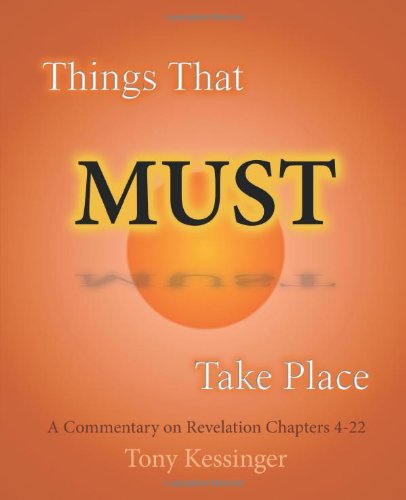by Tony Kessinger
★★★★★
This is a verse-by-verse commentary on everything in Revelation outside the letters to the churches. As a writer about Revelation myself, I must begin by pointing out how differently Kessinger and I read the Book of Revelation. Please pardon my upcoming rant–anyone who submits a book about Revelation to The Dubious Disciple can expect some critical analysis, ha–because Kessinger really does provide solid research, and I don’t want to leave the impression that it’s unscholarly. Tony holds a Ph.D. in religion, has “taught more than 1800 pastors and church workers on five continents,” and has published twice before.
Kessinger subscribes to a premillennialist view. He bemoans the way some scholars interpret Revelation too symbolically, and encourages us to “read the words literally unless they cannot be taken as such.” But if I follow his advice, noting the repeated promise that all would be fulfilled immediately, it would destroy Kessinger’s theme of “things that must take place,” replacing it with “things that took place as promised,” or maybe “things that were promised but failed to take place.” See verses 22:7, 22:10, 22:12, 22:20, 1:7, 3:11, and 11:17 plus a host of verses written in a tone of urgency to a first-century audience. A common promise made by Christ in Revelation is “Behold, I come quickly.” Kessinger largely ignores these, except to point out that since a long period of time has already gone by, our interpreters–who all use words like “quickly” or “soon” or “pronto” for the Greek word tachy–should substitute “suddenly,” as this word at least preserves the possibility of a 2,000 year wait. This odd substitution appears to me unwarranted, given the way the word tachy is used everywhere else in scripture. So, it’s hard for me to take the timing of Kessinger’s interpretation seriously.
Kessinger could come clean about the immediacy of Revelation’s message and its first-century setting if he wished; he just doesn’t. For example, he discusses how Antiochus IV serves as a typology of the antichrist to come, showing his appreciation for the historical setting of the book of Daniel, but neglects to do the same with Revelation’s ancient nemesis. The Beast of the Sea, according to the best Revelation scholars both conservative and liberal, is primarily identified as Roman emperor Nero Caesar. 666 = Nero Caesar, NRWN QSR, in the cryptology often used in religious writings of the first century. Much of the book of Revelation is about Nero Caesar. He’s the antichristic figure of the first century, the hated enemy of Christians, and the immediate threat John was warning about back then. This is all well-known today, and since no scholar of Revelation could possibly be unaware of Nero’s role, Kessinger’s refusal to even mention Nero betrays his one-sided interpretation.
In another example, Kessinger notes how Revelation chapter 9 is reminiscent of a volcanic eruption. Well, of course it is! Revelation was probably written just after perhaps the most famous volcanic eruption of all time; an eruption near Rome that buried an entire city (Pompeii) and spread famine for thousands of miles. An eruption so extreme that it happens somewhere on earth only about once every thousand years. How could any first-century Mediterranean apocalyptic book not be influenced by the eruption of Vesuvius?
Of course, Kessinger doesn’t consider Revelation to be apocalyptic. He considers all the other books like Revelation, written in the same time period, to be apocalyptic; just not Revelation. It’s special I guess … “from the mind of God,” Kessinger decides, not the mind of man, I assume because it eventually snuck into the Christian canon. This insistence that Revelation is in a genre of its own creates a problem. Kessinger’s research is deep and illuminating, but his modus operandi contains a weakness, which nearly cost him a five-star rating: He ignores a great deal of extra-canonical Jewish writings which can shed a lot of light on Revelation’s nuances. (I also felt like dropping one star when he asked us to tell our families about their fate of being eaten by birds if they don’t repent, but one isolated bit of hellfire evangelism can be forgiven, ha! This is, after all, the book of Revelation!)
Now on to the good side. Though Kessinger’s approach is blatantly canonical and futuristic, I nevertheless enjoyed it a lot. The insights are fresh and well-presented; not merely a rehash of other publications. The discussion of Antiochus IV as a typology was particularly well-done, and the comparison of the plagues of Egypt (from the book of Exodus) to the tribulations of Revelation is fascinating. As much as I’ve studied Revelation, I’ve never carried the comparison to Egypt’s plagues as far as Kessinger, so it definitely helped my understanding. Kessinger’s in-depth study of the Church as the Bride of Christ was also helpful (though it’s not emphasized as such in Revelation).
Though I hope this isn’t the only book you read about Revelation, I definitely recommend it for a premillennial view! Very good, if a little confusing about the timing of events in places. (Kessinger recognizes Revelation’s confusing order, and presents a chronological order of events in an appendix.)
CrossBooks, © 2013, 295 pages
ISBN: 978-1-4627-3432-0

